A High-Precision and Lightweight Prediction Model for Global Total Electron Content
Abstract
:1. Introduction
2. Model Structure and Data
2.1. Spatiotemporal Model
2.2. Dataset and Processing
2.3. Evaluation Metrics
3. Result and Discussion
3.1. Training and Test Result Analysis
3.2. Low Solar Activity Years
3.3. High Solar Activity Years
3.4. Comparison and Analysis of Testing Results
4. Conclusions
Author Contributions
Funding
Data Availability Statement
Conflicts of Interest
References
- McNamara, L.F. The Ionosphere: Communications, Surveillance, and Direction Finding; Krieger: Malabar, FL, USA, 1991. [Google Scholar]
- Kersley, L.; Malan, D.; Pryse, S.E.; Candetr, L.R.; Bamford, R.A.; Belehaki, A.; Leitinger, R.; Radicella, S.M.; Mitchell, C.N.; Spencer, P.S.J. Total electron content-A key parameterin propagation: Measurement and usein ionospheric imaging. Ann. Geophys. 2004, 47 (Suppl. S2–S3), 1067–1091. [Google Scholar] [CrossRef]
- Mannucci, A.J.; Wilson, B.D.; Yuan, D.N.; Ho, C.H.; Lindqwister, U.J.; Runge, T.F. A global mapping technique for GPS-derived ionospheric total electron content measurements. Radio Sci. 1998, 33, 565–582. [Google Scholar] [CrossRef]
- Bust, G.S.; Mitchell, C.N. History, current state, and future directions of ionospheric imaging. Rev. Geophys. 2008, 46. [Google Scholar] [CrossRef]
- Huba, J.D.; Joyce, G.; Fedder, J.A. Sami2 is Another Model of the Ionosphere (SAMI2): A new low-latitude ionosphere model. J. Geophys. Res. Space Phys. 2000, 105, 23035–23053. [Google Scholar] [CrossRef]
- Huba, J.; Krall, J. Modeling the plasmasphere with SAMI3. Geophys. Res. Lett. 2013, 40, 6–10. [Google Scholar] [CrossRef]
- Fesen, C.G.; Crowley, G.; Roble, R.G.; Richmond, A.D.; Fejer, B.G. Simulation of the pre-reversal enhancement in the low latitude vertical ion drifts. Geophys. Res. Lett. 2000, 27, 1851–1854. [Google Scholar] [CrossRef]
- Bilitza, D.; Pezzopane, M.; Truhlik, V.; Altadill, D.; Reinisch, B.W.; Pignalberi, A. The International Reference Ionosphere model: A review and description of an ionospheric benchmark. Rev. Geophys. 2022, 60, e2022RG000792. [Google Scholar] [CrossRef]
- Materassi, M. The Complex Ionosphere; Chapter 15 of this book; Elsevier Science: Amsterdam, The Netherlands, 2019. [Google Scholar] [CrossRef]
- Shim, J.S.; Kuznetsova, M.; Rastätter, L.; Hesse, M.; Bilitza, D.; Butala, M.; Codrescu, M.; Emery, B.; Foster, B.; Fuller-Rowell, T.; et al. CEDAR electrodynamics thermosphere ionosphere (ETI) challenge for systematic assessment of ionosphere/thermosphere models: NmF2, hmF2, and vertical drift using ground-based observations. Space Weather 2011, 9. [Google Scholar] [CrossRef]
- Liu, L.; Zou, S.; Yao, Y.; Wang, Z. Forecasting global ionospheric TEC using deep learning approach. Space Weather 2020, 18, e2020SW002501. [Google Scholar] [CrossRef]
- Chen, Z.; Liao, W.; Li, H.; Wang, J.; Deng, X.; Hong, S. Prediction of global ionospheric TEC based on deep learning. Space Weather 2022, 20, e2021SW002854. [Google Scholar] [CrossRef]
- Boulch, A.; Cherrier, N.; Castaings, T. Ionospheric activity prediction using convolutional recurrent neural networks. arXiv 2018, arXiv:1810.13273. [Google Scholar] [CrossRef]
- Liu, L.; Morton, Y.J.; Liu, Y. ML prediction of global ionospheric TEC maps. Space Weather 2022, 20, e2022SW003135. [Google Scholar] [CrossRef]
- Xia, G.; Zhang, F.; Wang, C.; Zhou, C. ED-ConvLSTM: A Novel Global Ionospheric Total Electron Content Medium-Term Forecast Model. Space Weather 2022, 20, e2021SW002959. [Google Scholar] [CrossRef]
- Lin, Z.; Li, M.; Zheng, Z.; Cheng, Y.; Yuan, C. Self-attention convlstm for spatiotemporal prediction. Proc. AAAI Conf. Artif. Intell. 2020, 34, 11531–11538. [Google Scholar] [CrossRef]
- Badrinarayanan, V.; Kendall, A.; Cipolla, R. Segnet: A deep convolutional encoder-decoder architecture for image segmentation. IEEE Trans. Pattern Anal. Mach. Intell. 2017, 39, 2481–2495. [Google Scholar] [CrossRef]
- Llewellyn, S.K.; Bent, R.B. Documentation and Description of the Bent Ionospheric Model; Rep. AFCRL-TR-73-0657; Air Force Geophys. Lab. Hanscom Air Force Base: Hanscom, MA, USA, 1973. [Google Scholar] [CrossRef]
- Guo, J.; Li, W.; Liu, X.; Kong, Q.; Zhao, C.; Guo, B. Temporal-spatial variation of global GPS-derived total electron content, 1999–2013. PLoS ONE 2015, 10, e0133378. [Google Scholar] [CrossRef]
- Shi, X.; Chen, Z.; Wang, H.; Yeung, D.-Y.; Wong, W.-K.; WOO, W.-C. Convolutional LSTM network: A machine learning approach for precipitation nowcasting. Adv. Neural Inf. Process. Syst. 2015, 28. [Google Scholar] [CrossRef]
- Calabia, A.; Jin, S. New modes and mechanisms of long-term ionospheric TEC variations from global ionosphere maps. J. Geophys. Res. Space Phys. 2020, 125, e2019JA027703. [Google Scholar] [CrossRef]
- Vaswani, A.; Shazeer, N.; Parmar, N.; Uszkoreit, J.; Jones, L.; Gomez, A.N.; Kaiser, Ł.; Polosukhin, I. Attention is all you need. Adv. Neural Inf. Process. Syst. 2017, 30. Available online: https://papers.nips.cc/paper_files/paper/2017/hash/3f5ee243547dee91fbd053c1c4a845aa-Abstract.html (accessed on 25 July 2023).
- Hu, J.; Shen, L.; Sun, G. Squeeze-and-excitation networks. In Proceedings of the IEEE conference on computer vision and pattern recognition, Salt Lake City, UT, USA, 18–23 June 2018; pp. 7132–7141. [Google Scholar] [CrossRef]
- Bergstra, J.; Bengio, Y. Random Search for Hyper-Parameter Optimization. J. Mach. Learn. Res. 2012, 13, 281–305. Available online: https://dl.acm.org/doi/10.5555/2188385.2188395 (accessed on 22 August 2023).
- Bauer, S.J. Physics of Planetary Ionospheres; Springer Science & Business Media: Berlin/Heidelberg, Germany, 2012. [Google Scholar] [CrossRef]
- Knipp, D.J.; McQuade, M.K.; Kirkpatrick, D. Understanding Space Weather and the Physics Behind It; Learning Solutions; McGraw-Hill: New York, NY, USA, 2011. [Google Scholar] [CrossRef]
- Tapping, K.F. The 10.7 cm solar radio flux (F10.7). Space Weather 2013, 11, 394–406. [Google Scholar] [CrossRef]
- Essex, E.A.; Mendillo, M.; Schödel, J.P.; Klobuchar, J.; da Rosa, A.; Yeh, K.; Fritz, R.; Hibberd, F.; Kersley, L.; Koster, J.; et al. A global response of the total electron content of the ionosphere to the magnetic storm of 17 and 18 June 1972. J. Atmos. Terr. Phys. 1981, 43, 293–306. [Google Scholar] [CrossRef]
- Dashora, N.; Sharma, S.; Dabas, R.S.; Alex, S.; Pandey, R. Large enhancements in low latitude total electron content during 15 May 2005 geomagnetic storm in Indian zone. Ann. Geophys. 2009, 27, 1803–1820. [Google Scholar] [CrossRef]
- Chakraborty, M.; Kumar, S.; De, B.K.; Guha, A. Effects of geomagnetic storm on low latitude ionospheric total electron content: A case study from Indian sector. J. Earth Syst. Sci. 2015, 124, 1115–1126. [Google Scholar] [CrossRef]
- Aggarwal, M. TEC variability near northern EIA crest and comparison with IRI model. Adv. Space Res. 2011, 48, 1221–1231. [Google Scholar] [CrossRef]
- Balan, N.; Liu, L.B.; Le, H.J. A brief review of equatorial ionization anomaly and ionospheric irregularities. Earth Planet. Phys. 2018, 2, 257–275. [Google Scholar] [CrossRef]
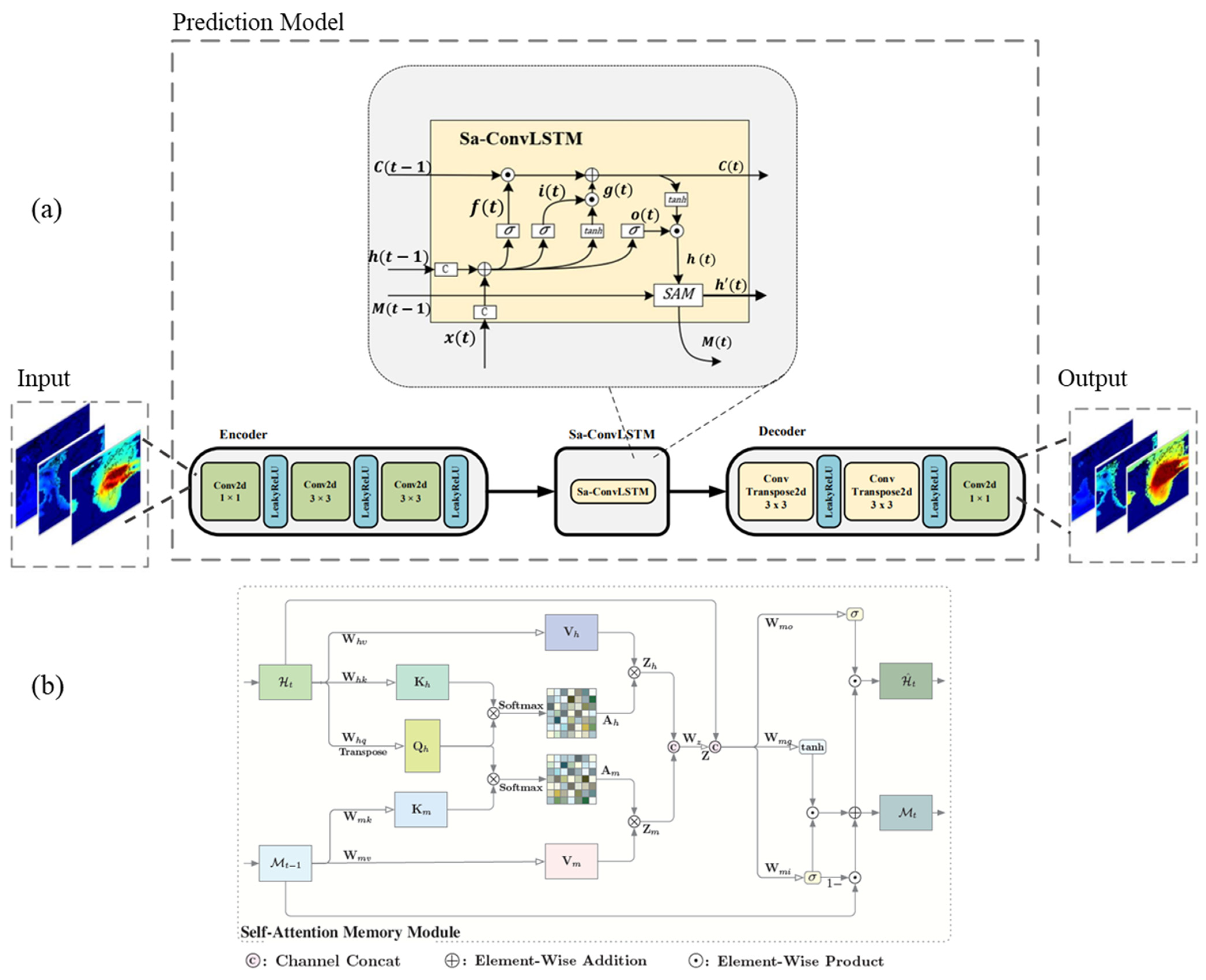
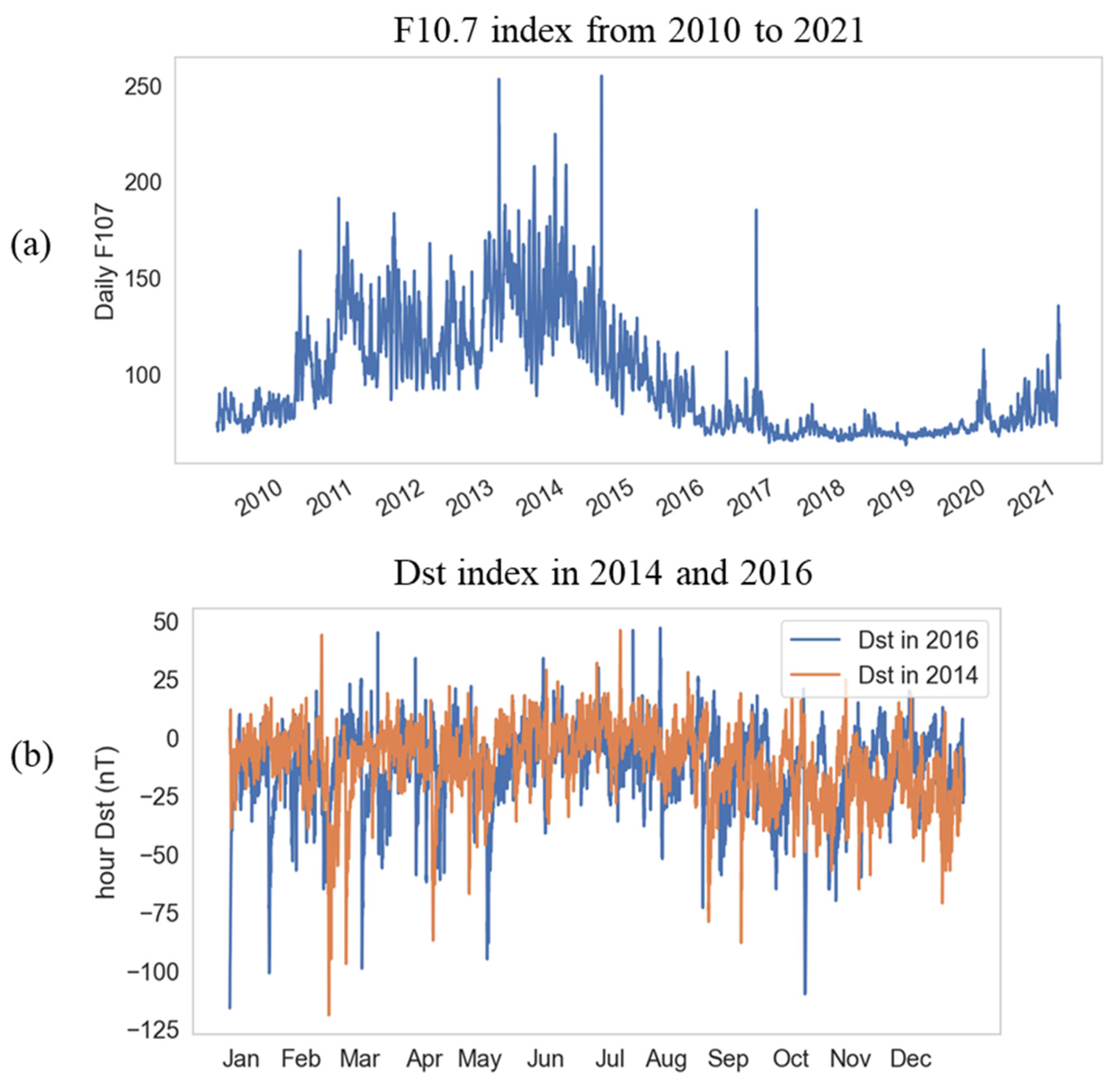
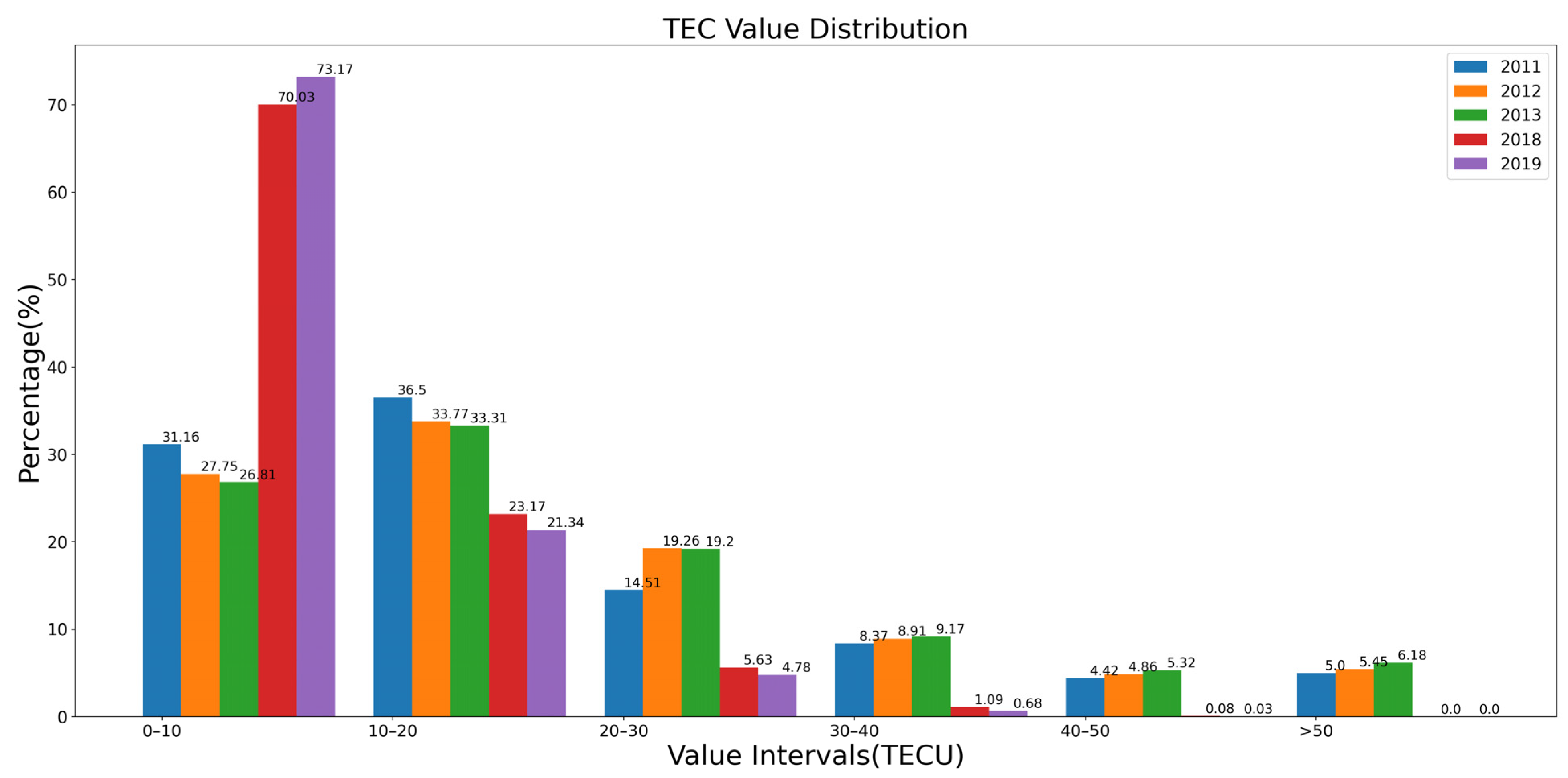

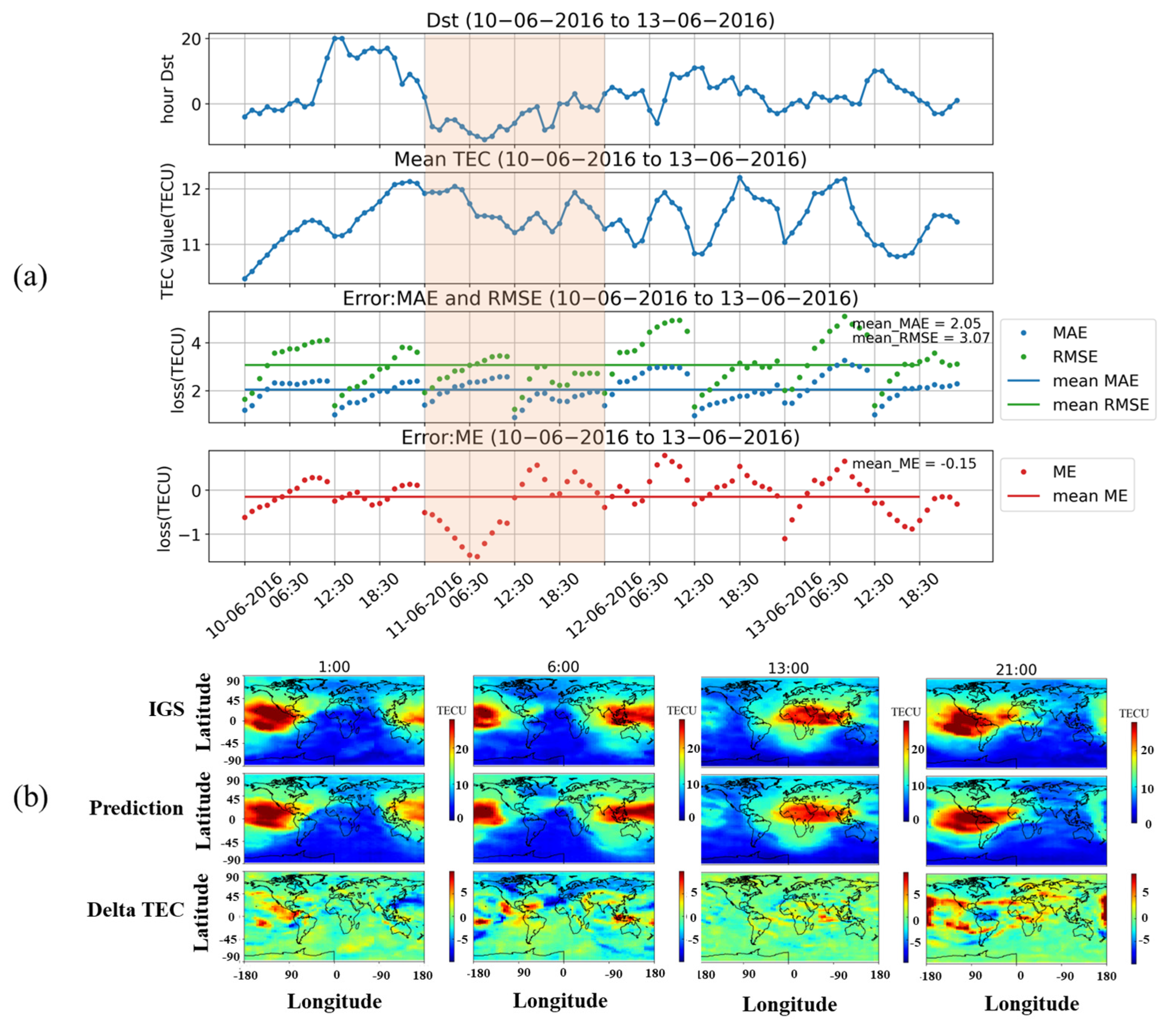
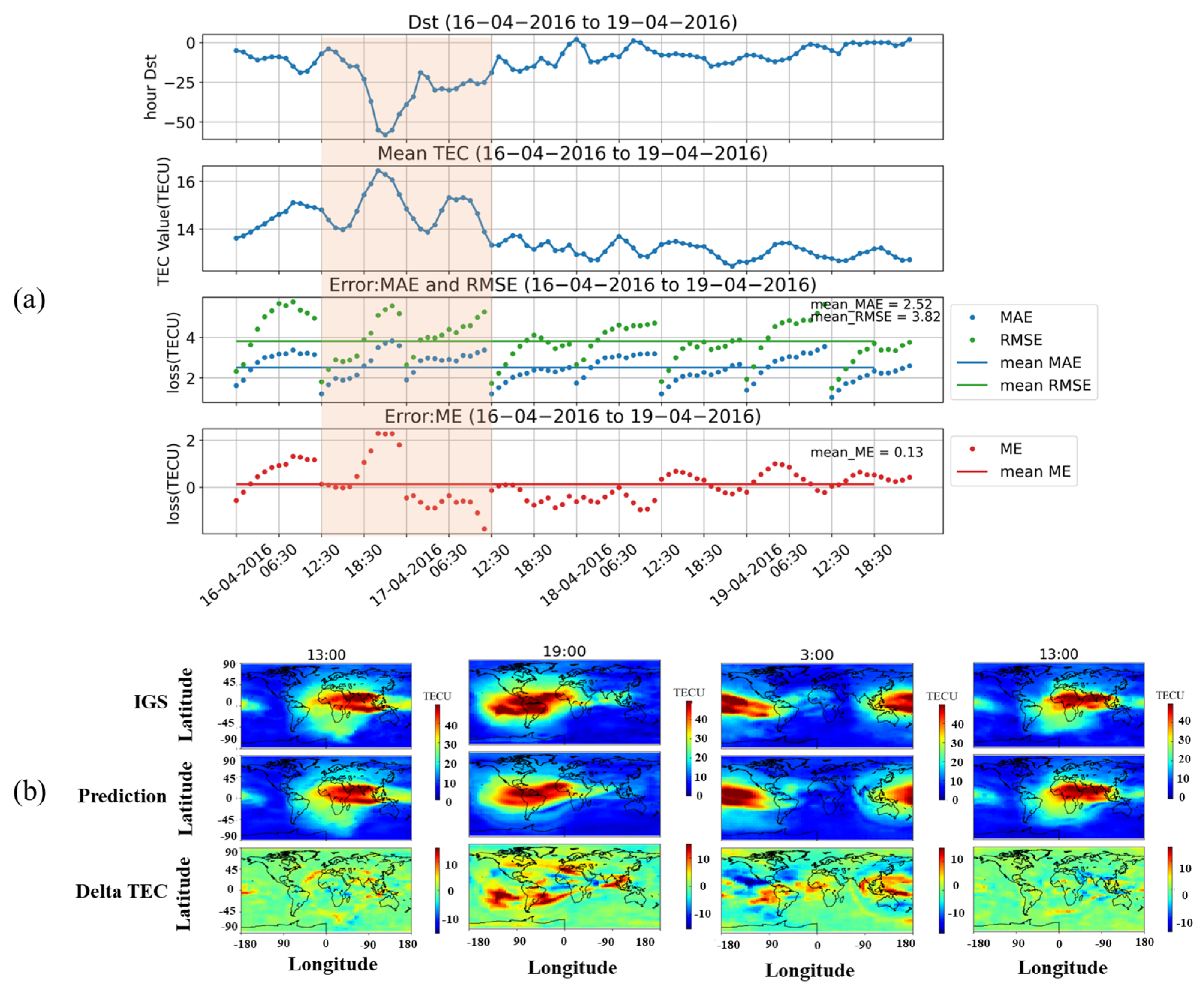
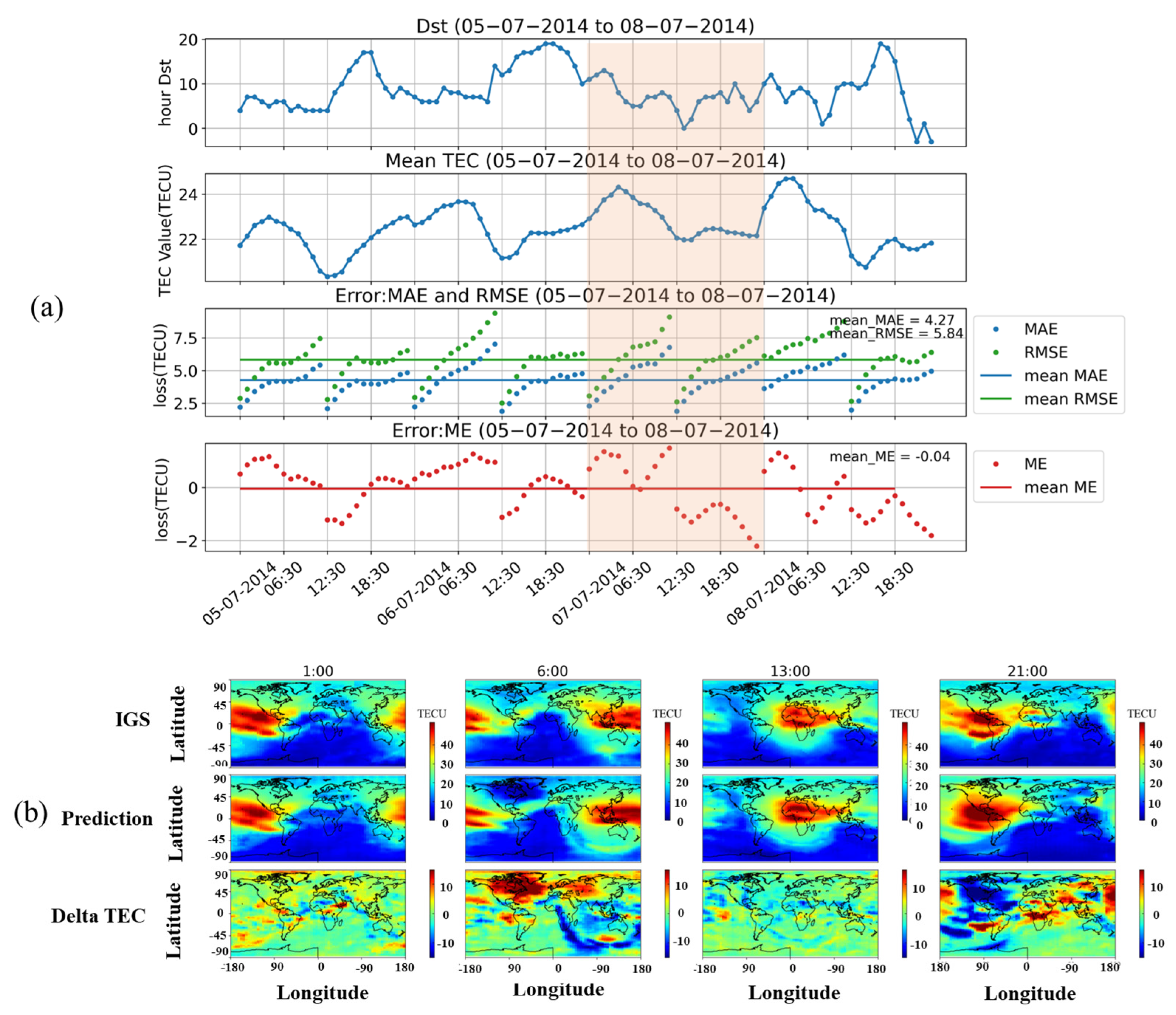
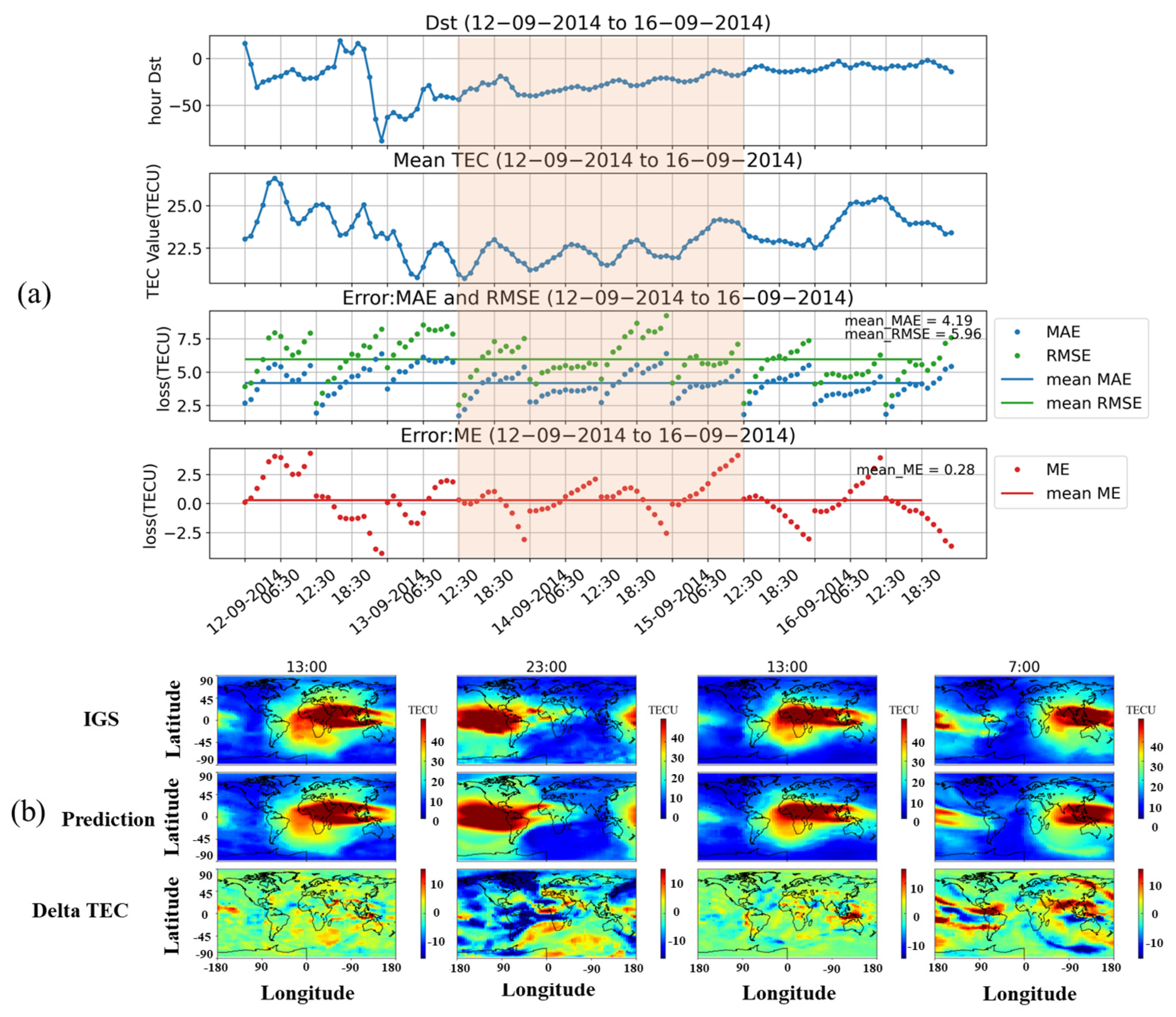
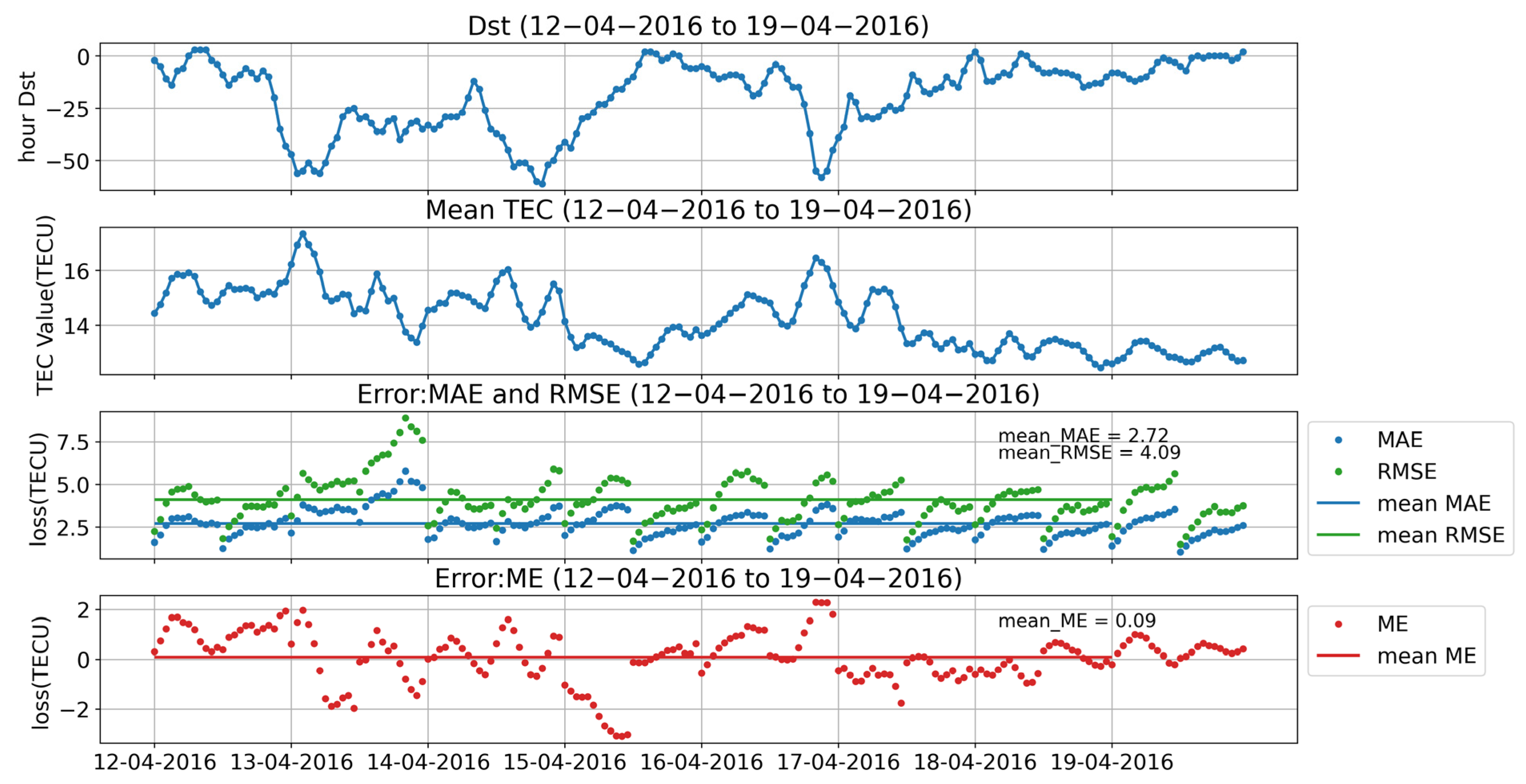
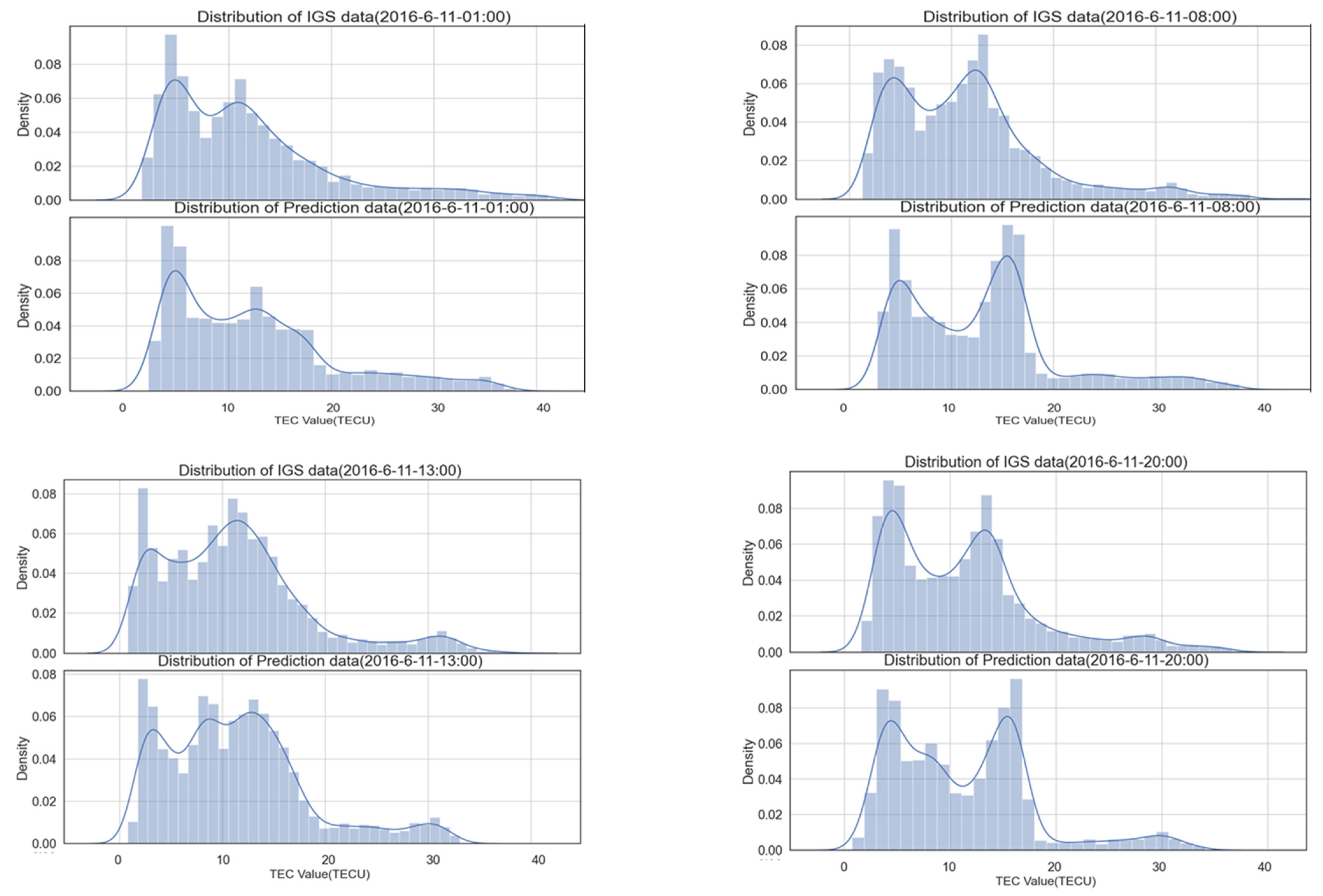

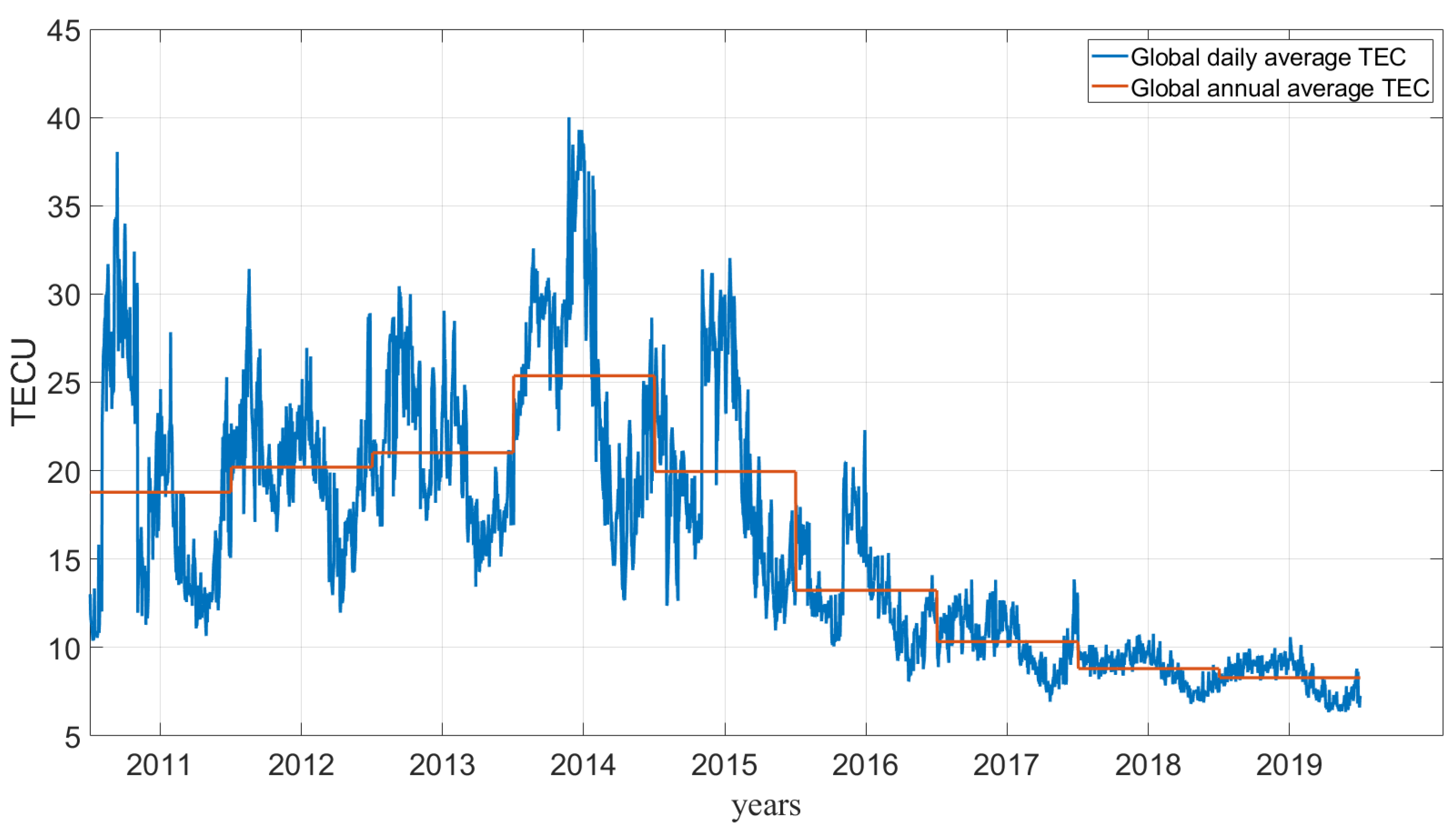
| Model Hyperparameters | Data Shape | ||||||
|---|---|---|---|---|---|---|---|
| Batch Size: 3 | Network | Module | Filter Size | Stride | Padding | Input Size | Output Size |
| Learning Rate: 0.001 | Encoder | conv2d | 1 × 1 | 1 × 1 | 0 × 0 | 71 × 73 | 71 × 73 |
| conv2d | 3 × 3 | 2 × 2 | 1 × 1 | 71 × 73 | 36 × 37 | ||
| conv2d | 3 × 3 | 2 × 2 | 1 × 1 | 36 × 37 | 18 × 19 | ||
| Epoch: 20 | Prediction Unit | Sa-ConvLSTM | —— | —— | —— | 18 × 19 | 18 × 19 |
| Loss Function: MAE | Decoder | convTransposed2d | 3 × 3 | 2 × 2 | 1 × 1 | 18 × 19 | 36 × 38 |
| convTransposed2d | 3 × 3 | 2 × 2 | 1 × 1 | 36 × 38 | 72 × 76 | ||
| conv2d | 1 × 1 | 1 × 1 | 0 × 0 | 72 × 76 | 72 × 76 | ||
| Optimizer: Adam | reshape | —— | —— | —— | 72 × 76 | 71 × 73 | |
| Activity Index | Threshold | Activity Level |
|---|---|---|
| F10.7 | high solar activity | |
| low solar activity | ||
| Dst | geomagnetic storm | |
| geomagnetic quiet |
| Test Period | Low Solar Activity | High Solar Activity | |||
|---|---|---|---|---|---|
| Error | Quiet | Storm | Quiet | Storm | |
| Max RMSE | 4.27 (2.10) | 4.51 (3.50) | 5.93 (3.80) | 6.12 (/) | |
| Min RMSE | 1.33 (1.78) | 1.71 (3.06) | 2.63 (3.31) | 2.98 (/) | |
| Max MAE | 2.74 (1.30) | 3.31 (1.85) | 4.19 (2.60) | 4.81 (/) | |
| Min MAE | 0.97 (1.09) | 1.17 (1.77) | 1.88 (2.30) | 2.01 (/) | |
| Model | SA-ConvLSTM | ConvLSTM | c1pg | |
|---|---|---|---|---|
| Error | ||||
| ME | 0.09 | −0.14 | −0.44 | |
| RMSE | 4.09 | 2.52 | 3.12 | |
Disclaimer/Publisher’s Note: The statements, opinions and data contained in all publications are solely those of the individual author(s) and contributor(s) and not of MDPI and/or the editor(s). MDPI and/or the editor(s) disclaim responsibility for any injury to people or property resulting from any ideas, methods, instructions or products referred to in the content. |
© 2023 by the authors. Licensee MDPI, Basel, Switzerland. This article is an open access article distributed under the terms and conditions of the Creative Commons Attribution (CC BY) license (https://creativecommons.org/licenses/by/4.0/).
Share and Cite
Yan, X.; Cai, H.; Xu, C.; Yang, L.; Zhan, W. A High-Precision and Lightweight Prediction Model for Global Total Electron Content. Remote Sens. 2023, 15, 4185. https://doi.org/10.3390/rs15174185
Yan X, Cai H, Xu C, Yang L, Zhan W. A High-Precision and Lightweight Prediction Model for Global Total Electron Content. Remote Sensing. 2023; 15(17):4185. https://doi.org/10.3390/rs15174185
Chicago/Turabian StyleYan, Xu, Hongtao Cai, Chen Xu, Lubing Yang, and Weijia Zhan. 2023. "A High-Precision and Lightweight Prediction Model for Global Total Electron Content" Remote Sensing 15, no. 17: 4185. https://doi.org/10.3390/rs15174185
APA StyleYan, X., Cai, H., Xu, C., Yang, L., & Zhan, W. (2023). A High-Precision and Lightweight Prediction Model for Global Total Electron Content. Remote Sensing, 15(17), 4185. https://doi.org/10.3390/rs15174185






